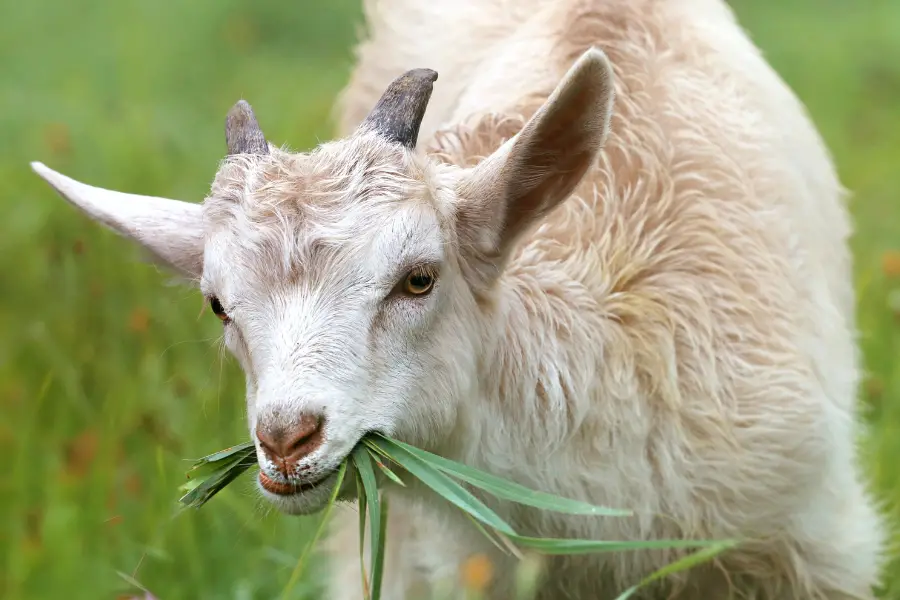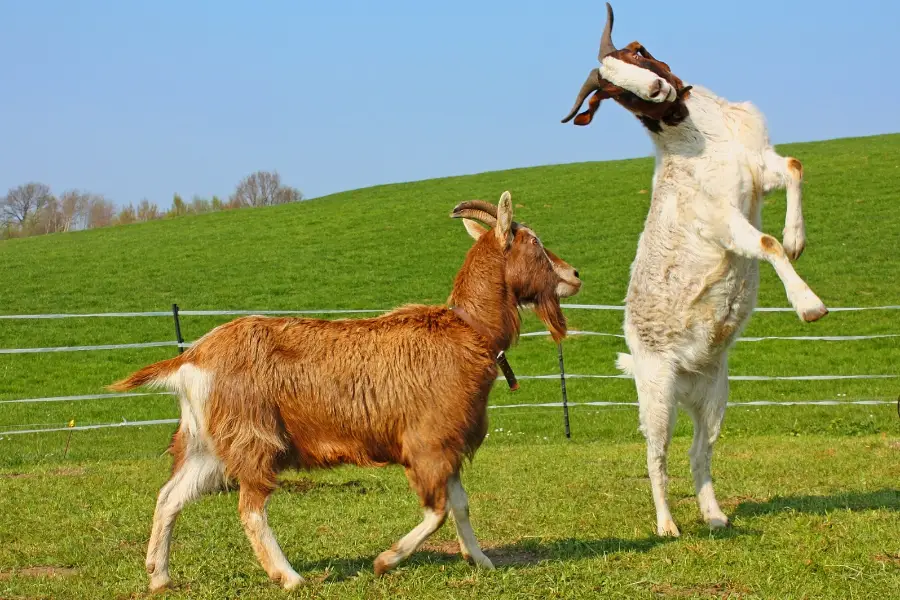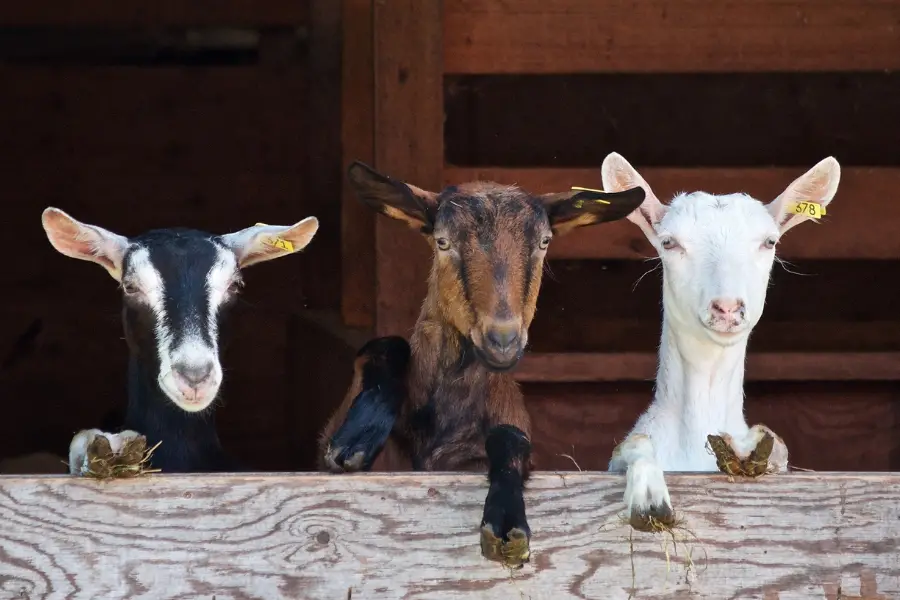
Table of contents
- Nigerian Dwarf Goat Origin
- Difference between Nigerian Dwarf Goats and Nigerian Pygmy Goats
- Nigerian Dwarf Goat Uses
- Nigerian Dwarf Goat Characteristics
- Nigerian Dwarf Goat Popularity
- Nigerian Dwarf Goat Price
- Nigerian Dwarf Goat Breeders
- Raising Nigerian Dwarf Goats
- Breeding Nigerian Dwarf Goats
- Nigerian Dwarf Goat Farming
- Raising Nigerian Dwarf Goats: Pros & Cons
- Nigerian Dwarf Goats Care: Top tips
- Nigerian Dwarf Goats for Sale: Where can I buy Nigerian Dwarf Goats in the USA?
- Nigerian Dwarf Goat Associations: What are the major Nigerian Dwarf Goat Associations in the USA?
- Training Nigerian Dwarf Goats: How hard is it? How to do it?
- Nigerian Dwarf Goat Pet – Do they Make Good Pets?
- Breeding Nigerian Dwarf Goats Video
- Nigerian Dwarf Goats FAQ Video
Nigerian Dwarf goats are compact, docile, and productive little animals…
Because they are smaller than standard goats, and have a friendly disposition, they are easier to manage and live with, making them popular as pets. But they are also low-maintenance dairy goats, giving a surprising amount of high-quality, high-fat milk despite their small size.
There are a growing number of people who appreciate the easy care and versatility of these goats, and they can be enjoyed both as companion animals and for profit in a dairy farm.
Nigerian Dwarf Goat Origin
The Nigerian Dwarf goats were originally bred in West Africa, where they were valuable for being easy to care for in harsh conditions, requiring less feed than other goats, but still being a source of meat and milk.
In the early- to mid-twentieth century, the goats were imported on ships along with big cats and African predators destined for American zoos. They were intended to be a low-maintenance food source for African predators on the long journey across the ocean.
Many goats survived the trip, and thus found a home in American zoos, where they became extremely popular in petting zoos due to their small size and friendly nature. Children are immediately attracted to these handsome, approachable little animals, and they soon found their way onto farms and pasture as pets.
Difference between Nigerian Dwarf Goats and Nigerian Pygmy Goats

If you are thinking that the breed history and American history of Nigerian Dwarf goats and Pygmy goats sounds extremely similar, you are correct. Both breeds are very similar in origins and uses.
The primary difference between Nigerian Dwarf goats and Nigerian Pygmy goats are their body proportions. Nigerian Pygmy goats tend to have stocky, barrel-like bodies, a bit like normal-sized goats with short legs. Nigerian Dwarf goats, on the other hand, are proportioned more delicately overall, like normal-sized goats scaled down smaller.
There are also two different breed standards for Nigerian Dwarf goats, depending on whether they are being used as dairy goats or not.
Nigerian Dwarf Goat Uses
Nigerian Dwarf goats are popular to have on a small farm for their overall usefulness and good nature, rather than their specific purpose. Here are a few reasons people enjoy Nigerian Dwarf goats:
- Like all goats, Nigerian Dwarf goats are useful in pastures to clear weeds and underbrush and improve grass for grazing animals. Their docile nature makes them easy to keep with grazing animals and not require special care or quarters
- As a livestock breed, they are eligible for 4H projects. They are small and easy to manage, making them an excellent candidate for children’s projects like 4H and FFA
- They give a good quantity of high-quality milk for their size. Their milk is exceptionally high in butterfat, making it excellent for goat cheese, creams, and other goat milk products, such as caramel, and goat milk candles. Goat milk also has less lactose than cow milk, and it contains different proteins. As a result, it can be a good option for those with dairy sensitivities.
- They are polyestrous and can be bred all year long, so a small number of does can maintain a steady supply of milk
- They typically produce 3-5 kids per kidding, so a small herd can grow fast, or kids and wethers can be sold as pets
- They are very popular simply as pets and companion animals, and their small size makes them easy to live with even in more urban settings.
- They are excellent animal for goat yoga
In short, for people who already have a small or large farm, it’s easy to simply add Nigerian Dwarf goats and enjoy their many benefits. And for those looking for a fun, friendly, charming pet, a Nigerian Dwarf goat doesn’t require much more space or care than most breeds of dog.
Nigerian Dwarf Goat Characteristics
As mentioned above, Nigerian Dwarf goats have two different breed standards. The American Goat Society and American Dairy Goat association have different conformation standards than the Nigerian Dwarf Goat Association.
Appearance
Generally speaking, Nigerian Dwarf goats should look like a smaller version of Swiss Alpine goats. AGA standards allow any coat and have no preference for brown or blue eyes (blue eyes are common in the breed, but uncommon in other dairy goats). NDGA standard disallows curly hair, a Roman nose, and pendulous ears.
Size
AGA standards require Nigerian Dwarf does to be no taller than 22.5 inches at the withers, and bucks to be no more than 23.5 inches. NDGA standards allow does no taller than 21 inches at the withers, and bucks to be no taller than 23 inches.
Production
Nigerian Dwarf does give 1-8 pounds of milk per day when lactating, with an average of 2.5 pounds per day. Their milk averages 6.5% butterfat, but can reach as high as 10% late in lactation.
Disposition
Nigerian Dwarf goats are known for being friendly, playful, and outgoing. They seek out and enjoy interacting with people, and will respond readily to vocal calls. Many people bottle feed them to ensure human bonding and make them better pets, but many others feel that bottle feeding makes them actually too human dependent and demanding.
Nigerian Dwarf Goat Popularity
Nigerian Dwarf goats are charming, petite creatures that have captured the hearts of animal enthusiasts worldwide. Their small size, friendly nature, and versatility make them popular pets, dairy animals, and show animals. While Nigerian Dwarf goats can be found in various parts of the world, there are certain regions where their popularity truly shines. In this article, we will explore some of the places where Nigerian Dwarf goats are most popular and the reasons behind their widespread appeal.
1. United States
The United States is undeniably one of the primary countries where Nigerian Dwarf goats have gained significant popularity. From small-scale hobby farms to larger commercial operations, these goats can be found in many states across the nation. The popularity of Nigerian Dwarf goats in the United States can be attributed to several factors:
- Versatility: Nigerian Dwarf goats are highly versatile animals, serving as ideal companions, milk producers, and even show animals. Their small size makes them suitable for both rural and urban settings, appealing to a broad range of people.
- Milk Production: Nigerian Dwarf goats are renowned for their rich and flavorful milk, despite their small stature. This trait has made them popular among dairy enthusiasts who value high-quality, easily digestible milk for personal consumption or artisanal cheese production.
- Adaptability: These goats adapt well to various climates, which is essential in a country as geographically diverse as the United States. They can thrive in both cold and hot environments, making them accessible to individuals living in different regions.
2. Nigeria
Unsurprisingly, Nigeria, the country from which the breed originated, is another region where Nigerian Dwarf goats enjoy immense popularity. In Nigeria, these goats are appreciated for their economic value and their ability to provide sustenance for families in rural areas. The reasons behind their popularity in Nigeria include:
- Traditional Farming: Nigerian Dwarf goats have been part of Nigerian farming practices for centuries. They are often kept for their milk, meat, and as a source of income through sales or bartering. Their small size allows them to thrive in smaller plots of land, making them an ideal choice for small-scale farmers.
- Cultural Significance: Nigerian Dwarf goats hold cultural significance in Nigeria, particularly among various tribes. They are used in ceremonies, rituals, and traditional festivities, cementing their place as an integral part of Nigerian heritage.
3. Europe
In recent years, Nigerian Dwarf goats have gained popularity across several European countries, including the United Kingdom, Germany, France, and the Netherlands. The reasons for their increasing appeal in Europe are:
- Urban Farming: The rise of urban farming and sustainable living has led to a growing interest in Nigerian Dwarf goats. Their small size and friendly temperament make them suitable for urban dwellers who have limited space but still desire to experience the joys of raising livestock.
- Natural Land Management: Nigerian Dwarf goats are adept at browsing and grazing, making them excellent natural land managers. They are often employed for vegetation control in ecologically sensitive areas, such as nature reserves, where their grazing helps maintain the balance of flora and fauna.
Popularity Outlook
Nigerian Dwarf goats have captured the hearts of animal enthusiasts in various regions around the world. From the United States, where they thrive in diverse climates, to Nigeria, their country of origin, where they hold cultural significance, and Europe, where they serve urban farming and land management purposes, these charismatic goats continue to win over admirers with their charm, versatility, and practical value. Whether as beloved pets, dairy animals, or working partners, Nigerian Dwarf goats have secured their place as a cherished breed globally.
Nigerian Dwarf Goat Price
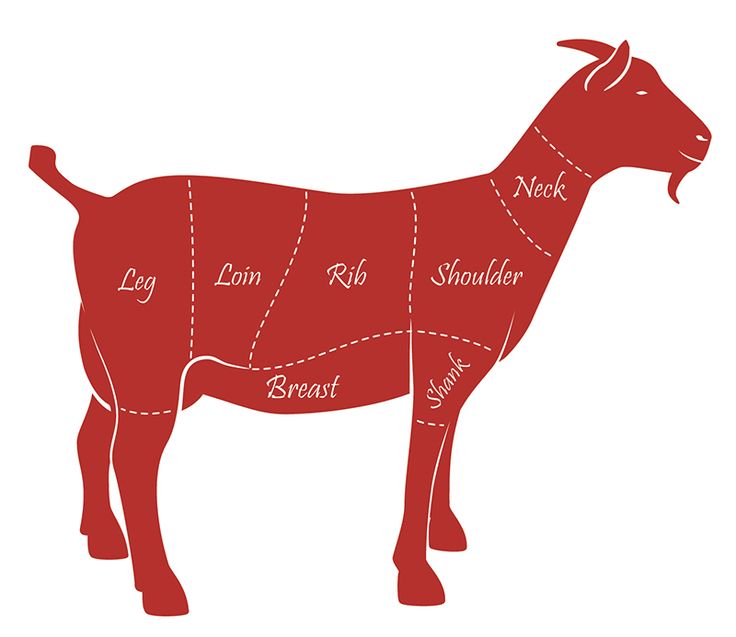
The cost for registered Nigerian Dwarf breeding stock is $200-$500 per goat, depending on their availability and bloodline. Wethers to be sold as pets are generally available for as little as $50-$100.
Nigerian Dwarf Goat Breeders

The best source for the best Nigerian Goat breeders is the website of the Nigerian Dwarf Goat Association.
Raising Nigerian Dwarf Goats
Nigerian Dwarf goats are adaptable to a variety of weather conditions and are a low-maintenance animal.
Known to be sociable and friendly, their small size makes them easier to care for than larger goat breeds, because they require less space and less feed.

Nigerian Dwarf goat social needs
Like all goats, Nigerian Dwarfs are herd animals and will not be healthy or happy when kept alone. If you are keeping a Nigerian Dwarf as a pet, they will often not do well in an environment where they are alone for extended periods. Keeping them with other goats, or even with grazing animals or dogs, will help satisfy the social needs of this outgoing little animal.
Nigerian Dwarf goat medical needs
Like all goats, Nigerian Dwarf need periodic hoof trimming and deworming, depending on their diet and lifestyle. Most people trim hooves every 4-8 weeks, deworm several times a year, and vaccinate annually. Fortunately, their small size makes handling them easy. Make sure you have access to a veterinarian who is familiar with the needs of goats.
Nigerian Dwarf Goat Food Needs

Water
Goats should always have access to fresh, clean water. Remember that your Nigerian Dwarf goats will need more water than usual in hot weather or when lactating.

Forage and feed
Nigerian Dwarf will happily browse on shrubs, weeds, herbs, and leaves. Allowing them freedom of pasture also gives them the exercise they need to stay healthy and prevent health problems. Depending on the size of your pasture, the variety of plants available, and the season, alfalfa hay can and should be offered for free feeding.
Purchase very high-quality hay for the healthiest goats and best quality milk. Alfalfa hay is high in calcium, which is essential when goats are kidding and producing milk. Alfalfa hay can be expensive, so some people supplement other high-quality hay with alfalfa pellets instead. Grain is a desirable source of extra nutrition when a goat is producing milk, but is not strictly necessary.
Supplements
Depending on the plants in your pasture, local soil composition, and nutritional composition of your hay, it is likely that your goats will need mineral supplements. If you are providing high-quality food, they may only require small amounts of trace minerals.
When free-fed, goats will only eat as much mineral supplements as they need. Use a mineral supplement designed for goats or cattle, and avoid supplements designed for sheep, because goats and cows require copper, which is toxic to sheep. You can also feed your Nigerian Dwarf goats fruit and vegetable scraps from the kitchen to add variety to their diet.
Nigerian Dwarf goat enclosure needs
Like all goats, Nigerian Dwarfs are agile and ready jumpers, and require ample space to roam and exercise to prevent unnecessary wear and tear on your fencing. Many people provide toys for their Nigerian Dwarf goats, to suit their playful nature and need for exercise.
They will welcome tree stumps, cable spools, and even large rocks for climbing and jumping, but keep these toys well away from fences. Their small size limits how high they can jump, and naturally reduces the potential for damaging your fences and enclosures.
Remember that fences not only keep goats in, but should keep predators out, and Nigerian Dwarfs are especially susceptible to predation, depending on your local wildlife. Even some stray dogs can pose a threat to Nigerian Dwarfs.
Fences should be about 4 feet high since Nigerian Dwarf goats can’t jump higher than that. Goats will lean, stand, rub, and chew on fencing, particularly if they have smaller pasture, or if there seems to be attractive forage on the other side, so posts should be no further than 8 feet apart.
The best way to secure your Nigerian Dwarf goats is with a woven wire fence with 2×4-inch openings too small for adults to put their heads through: woven wire is strong enough to withstand the chewing, leaning, and standing that the fence will endure. Woven/goat wire can be purchased in rolls that are already 4 feet high.
Nigerian Dwarf goat shelter needs

All goats need shelter at night and in poor weather. Situate your shelter well away from your fence, so that goats aren’t able to jump from the roof of their shelter over the fence, and avoid situating the shelter on low ground that would accumulate rain.
Many people find that a normal dog house is perfect for a Nigerian Dwarf buck or a dry doe. It is better to have a dry dirt floor than a wood one; wood flooring can get slippery with mud or manure, and potentially injure a goat or cause foot problems.
Breeding Nigerian Dwarf Goats

Nigerian Dwarf does can come into heat when they are as young as 4 months, but breeding them that early should be avoided, and it’s better to wait until they are 8-12 months old.
They are polyestrous, and will come into heat when they are exposed to a male, so it’s a good idea to keep young does away from bucks until you are ready for them to breed.
Keep in mind that bucks can breed at as young as 2 months old, and they should be kept away from does if you don’t intend any accidental pregnancies. They are prolific breeders, and does can give birth to 3-4 (sometimes even 5!) kids per kidding.
When a doe is coming into heat, she will generally show signature behaviors, such as:
- Tail flagging
- Signs of mucous or discharge
- Swollen rear end
- More pronounced or unusual yelling or bleating
- If she is exposed to a buck, she will usually show greater interest in him and seek him out.
Nigerian Dwarf goats produce milk for about 300 days per freshening, and breed throughout the year, rather than seasonally. This makes their polyestrous nature favorable. If you want a steady supply of delicious, high-quality goat milk, you only need a couple does, and to stagger their breeding.
If you plan to breed Nigerian Dwarf goats, it is good to have some overlap in their milk production, because of the high possibility of having 5 kids in a kidding; a doe may give birth to more kids than she can nurse, and having another lactating doe available allows fostering or bottle feeding.
Breeding Nigerian Dwarf goats presents the challenge that all goat farmers have: keeping a buck so that you can breed your goats when desired, but isolating him from the does so that they don’t breed to early, or more than once. Even relatively small Nigerian Dwarf bucks can be quite determined when they want to access a receptive doe, so their enclosure needs to be very sturdy.
And even bucks that need to be separated from the herd still have social needs, and should be kept with other animals or a wether for company. However, unlike many breeds, Nigerian Dwarf bucks are more docile and easy to handle, so they are less of a challenge to keep or contain.
If you choose to keep a buck, it is best to not have him share a fence with the does. Goats are resourceful, and have been known to breed through fences. Create an enclosure for the buck, with a clear area of 15 or more feet between it and the enclosure for the does. This buffer zone will not only prevent unwanted breeding through the shared fence, but it will also discourage him from attacking the fence and putting undue strain on it.
As an alternative, you may find a neighbor with a buck and arrange periodic “dates” for your does when you are ready for them to come into season and to breed. This is a popular method for keeping constant milk production, while avoiding some of the expense and challenge of owning your own buck.
Nigerian Dwarf wethers make excellent and popular pets, and this popularity as a pet helps to reduce some of the stress of figuring out what do to with the unneeded male kids born several times a year. It is also a good source of additional income from a Nigerian Dwarf goat farm.
Nigerian Dwarf Goat Farming
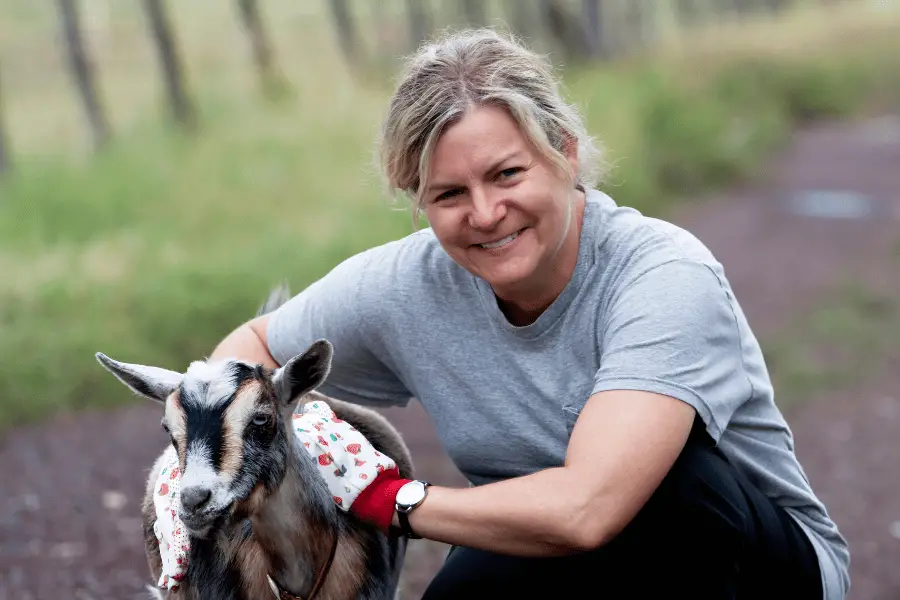
Nigerian are calm, pleasant creatures, and like the Pygmy goat, they hail from West Africa. They come in a variety of colors and are known for producing large quantities of milk. Legally, does are not supposed to exceed 22-½ inches and bucks no more than 23-½ inches.
Raising Nigerian Dwarf Goats: Pros & Cons
Pros
- They produce up to 800 pounds of protein-rich milk annually. Their milk is high is butterfat with a level of up to 10%.
- Nigerian Dwarf goats are pretty tiny which means they don’t require a lot of living space, and they’re easy to handle.
- This breed can produce kids year-round which makes them valuable. Nigerian Dwarf goats can cost anywhere between $300 and $500.
Cons
- Nigerian Dwarf goats go into heat every month.
- This breed eats everything in sight. Beware if you have a garden.
- Nigerian Dwarf goats make A LOT
Nigerian Dwarf Goats Care: Top tips
- Even though they’re small, Nigerian Dwarf goats need plenty of room to live and roam around.
- This breed is tough and can easily escape from their containment areas if they aren’t strong enough. Make sure you get a fence that’s tall and durable.
- Nigerian Dwarf goats can quickly become lonely if they’re the only one. If you’re looking to start a farm, start with at least two so that they have a companion.
- A large dog house can be an adorable, alternative shelter option to protect your Nigerian Dwarf goat from harsh weather conditions.
Nigerian Dwarf Goats for Sale: Where can I buy Nigerian Dwarf Goats in the USA?
We have created an extensive directory of Nigerian Dwarf Goat Breeders. You can search for breeders in your state.
Nigerian Dwarf Goat Associations: What are the major Nigerian Dwarf Goat Associations in the USA?
- The American Nigerian Dwarf Goat Association
- The American Dwarf Goat Association
- The Nigerian Dwarf Goat Association
Training Nigerian Dwarf Goats: How hard is it? How to do it?
Training goats, in general, takes patience. It can be hard to teach an older Nigerian Dwarf goat new tricks. Start them off young, and make them feel loved as they’re learning. Here are a few more tips to keep in mind when training your Nigerian Dwarf.
- The good thing about Nigerian Dwarves is that they’re quick learners. Show your goats where you want them to go, then give them little treats for doing what you want. Repeating this a few times will help you ND’s break into your routine.
- Goats love food, so treating them with foods they love will encourage them to follow your instructions. These foods may include but are not limited to animal crackers, carrots, hay, and goat treats.
- Don’t force your goat to do anything. If you want to see results, nurture them with guidance and patience and they’ll be doing what you want in no time.
- Establish a trusting and loving relationship with your Nigerian Dwarf, and they’ll be eager to comply with your wants.
Nigerian Dwarf Goat Pet – Do they Make Good Pets?
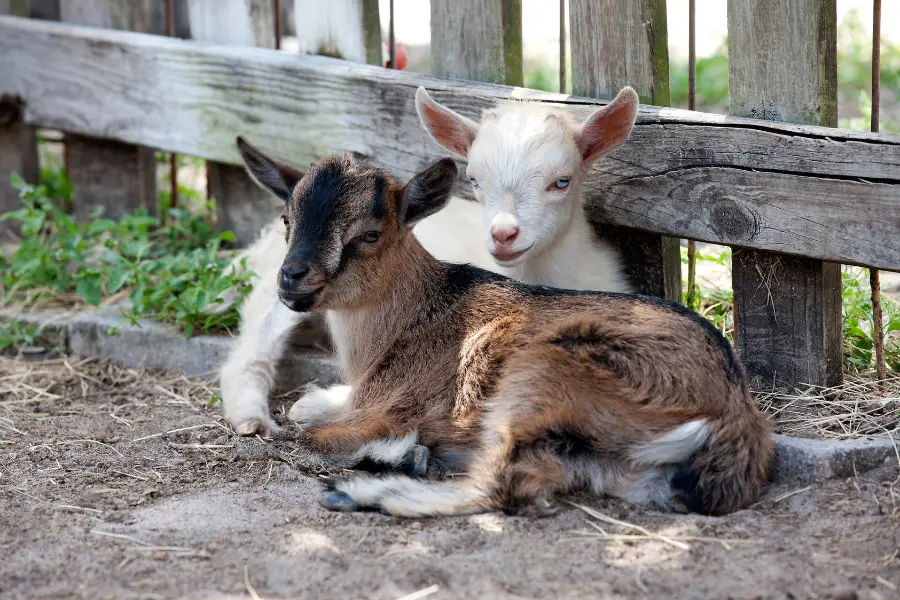
According to the NDGA, Nigerian Dwarfs make wonderful pets due to their size and playful personalities. This, along with their sweet temper, makes them a family-friendly addition that can easily get along with your other pets.
Breeding Nigerian Dwarf Goats Video
A short video on breeding Nigerian Dwarf Goats:
Nigerian Dwarf Goats FAQ Video
You can skip to 1:50 in the video below:
References


